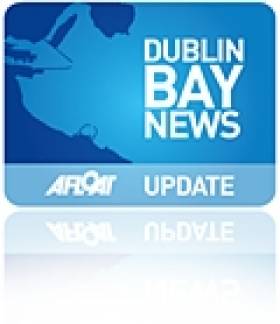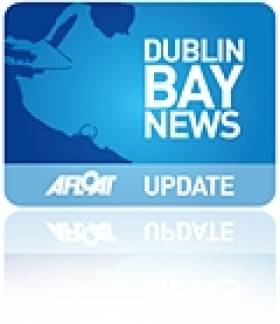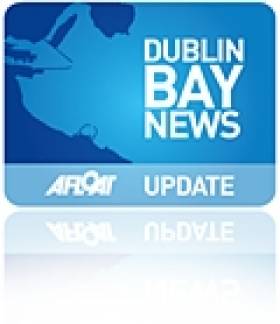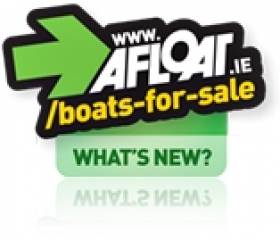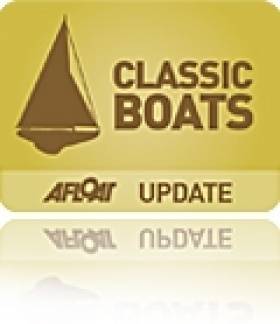Displaying items by tag: Dun Laoghaire Marina
Largest Ever Superyacht Berths at Dun Laoghaire Marina
The impressive 150–foot Latitude motoryacht arrived into Dun Laoghaire marina last night via the northwest passage, Greenland and Iceland. It is so far the largest super yacht to berth at the town marina and today's weather means Dublin Bay is offering some milder conditions than might have recently been experienced onboard. Reports from her east coast mooring say her crew and guests are very much enjoying Dun Laoghaire in late autumn sunshine.
Superyacht Latitude is for sale and available to charter in the Mediterranean next summer, according to Boat International.
Twin 720hp Caterpillar engines give her a cruising speed of 10 knots and a range of 4,000 nautical miles. The Benetti yacht detoured via the Isle of Man to pick up a 10m triple engined tender before arriving in Dun Laoghaire.
The 45 metre tri-deck superyacht Latitude is on the market through Yachtzoo in Fort Lauderdale. Designed by Vripack and built to DNV class and MCA compliant by Russia''s Timmerman yard in 2009. Latitude has an interior by Bannenberg and Rowell accommodating up to 13 guests in five staterooms. All for a cool €14,950,000 according to Boat International.
Other superyachts to berth in Dun Laoghaire recently include superyacht Christopher and Arcadia.
MT. @BoatyardMgm #luxury #superyacht #latitude in #DunLaoghaire today. @DLHarbour pic.twitter.com/ZINou5Ifqo
— Dun Laoghaire Marina (@DLMarina_Dublin) October 20, 2015
Dun Laoghaire Marina Keeps Its 5 Gold Anchors
#IrishMarinas - Dun Laoghaire Marina announced today (Monday 27 July) that it has retained its 5 Gold Anchors status, the highest rating awarded under The Yacht Harbour Association's (TYHA) Gold Anchor Award Scheme.
The news comes not long after TYHA representatives received a warm welcome from Dun Laoghaire and other 5 Gold Anchor marinas such as Kinsale during the body's recent summer networking tour of Ireland.
Pierce Brosnan & Anna Friel Posing at Dun Laoghaire Marina
#007 – The gossip that former 007 James Bond star Pierce Brosnan was filming in Dublin with British actress Anna Friel proved correct tonight when the pair arrived at Dun Laoghaire Marina.
The stars were on the Dun Laoghaire waterfront filming new movie 'I.T'., a film in which Pierce Brosnan stars as a book publisher.
Deadline.com, which broke the story, says the new film pits Brosnan's character against a disgruntled IT consultant who threatens his family and business.
Friel, a London based actress, plays Brosnan's wife in the revenge thriller. In an earlier scene, this afternoon the pair were also filming near the now vacant HSS Ferry terminal.
Brosnan also dropped into the Dun Laoghaire harbour based Irish yacht broker MGM Boats and is pictured below with its managing director Gerry Salmon.

Round Ireland Yacht Race – Where Next? What Next?
#roundireland – The biennial Round Ireland Race from Wicklow is the jewel in Ireland's offshore racing crown. It may only have been established as recently as 1980, but now it is a classic, part of the RORC programme, and an event which is very special for those who take part. In fact, for many Irish sailing folk, having at least one completed Round Ireland Race in your sailing CV is regarded as an essential experience for a well-rounded sailing life. Yet despite fleets pushing towards the 60 mark in the 1990s, even before the economic recession had started tobite the Round Ireland numbers were tailing off notwithstanding the injection of RORC support, and the more recent bonus of it carrying the same points weighting as the Fastnet Race itself. At a time when the basic Fastnet Race entry list of 350 boats is filled within six hours of entries opening for confirmation, and when the Middle Sea Race from Malta has confidently soared through the 120 mark, while the 70th Sydney-Hobart Race in seven weeks time will see at least a hundred entries, the Round Ireland Race fleet for 2014 was only 36 boats, of whom just 33 finished. W M NIXON wonders how, if at all, this situation can be improved.
"The Round Ireland Race is the greatest. Why don't more people know about it? Why aren't there at least a hundred top boats turning up every time it starts? It's a marvellous course. We had great sailing and great sport. Can somebody tell me why a genuine international offshore racing classic like this has been going on for 34 years, and yet in 2014 we see an entry of only three dozen boats?"
The speaker isn't just any ten-cents-for-my-opinion waterfront pundit. On the contrary, it's Scotsman Richard Harris, skipper and part-owner with his brother of the potent 1996 Sydney 36 Tanit, the overall winner of the Round Ireland Race 2014. And he's asking these questions as someone who has raced with success in both the Fastnet and Sydney-Hobart Races, and has campaigned his boat at the sharp end of the fleet with the RORC programme from the Solent, and in any worthwhile offshore racing he has managed to find in his home waters of Scotland.
Harris is getting into fine form, as we're at the Tanit table for Wicklow Sailing's Club's Round Ireland Prize-giving Dinner-Dance in the Grand Hotel in Wicklow town last Saturday night. With a boxload of trophies for Tanit to collect, anyone would be in exuberant spirits. But his views on the quality of the Round Ireland Race are clearly thought out and genuinely held, and he is enthusiastically supported by his navigator, Richie Fearon.
Fearon is the man to whom the Tanit crew give the lion's share of the credit for their success, which was achieved by just six minutes from Liam Shanahan's J/109 Ruth from the National YC in Dun Laoghaire. He was the only one in Tanit's crew who had done the race before, and in an all-Clyde lineup, his was the only Irish voice, as he sails from Lough Swilly YC in Donegal. His previous race was in 2010 with the Northern Ireland-based J/124 Bejaysus (Alan Hannon), which finished 7th overall. But for the Derry man, second time round made the course if anything even more interesting.
"You get a wonderful sense of the race progressing all the time, of moving along the course" says Fearon. "In the Fastnet, for instance, there are periods when you feel as though you're sailing in a sort of limbo. But in the Round Ireland, you're always shaping your course with the next rock or island or headland or wind change or tidal time in mind. There's a fascinating and challenging mix of strategy and tactics and navigation and pilotage, all of which results in one of the most interesting distance races in the world. They really should get more people to do it. It gives a wonderful feeling of achievement and completeness when you just finish the course. And it's even better if you do well, as we felt we'd done in 2010. But believe me, winning overall, and in a boat as interesting as this with a crew of guys as good and as friendly as this, that's the best of all!"
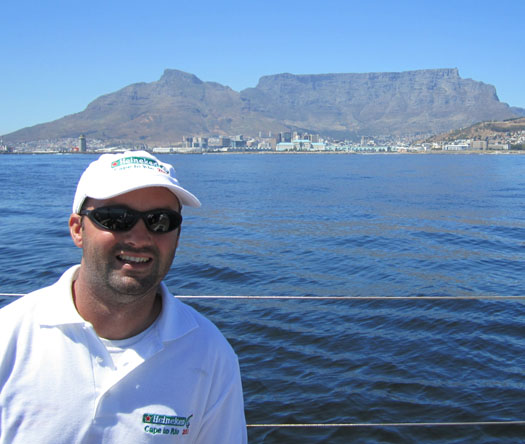
Richie Fearon of Lough Swilly YC, seen here kitted up off Cape Town for the Transatlantic race to Rio, navigated Tanit to the overall victory in the Round Ireland 2014
So how do you explain to such people, people who have become Round Ireland enthusiasts with all the zeal of recent converts, just why it is that Ireland's premier offshore event can barely attract a viable quorum when the yacht harbours of Europe are bursting with high-powered offshore racing boats which are constantly on the lookout for events worthy of their attention, not to mention commercial offshore racing schools and training programmes which need events like the Round Ireland Race to stay modestly in business?
How indeed, when we already have enough difficulty in explaining it all to ourselves. Inevitably, we have to look at the history, and the setting of that history. The last time I was at the Round Ireland Prize-Giving Dinner-Dance in Wicklow, there'd been enough participants from my home port of Howth in that year's race to make it worthwhile for us to hire a bus to go down through the Garden County for the party. We were in the midst of the Celtic Tiger years when people's expectations were becoming very pretentious, and I remember two foodies seated nearby in the bus pompously hoping to high heaven that the evening's meal wouldn't be the inevitable rural feast of beef or salmon.
But the charm of Wicklow town is that, though it's barely a forty minute drive from the capital, it is very much of the country - l'Irlande profonde as you might say. 'Tis far you are from big city notions of fancy menus to appeal to jaded metropolitan taste-buds. So it was indeed beef or salmon. Not that it really mattered that much to the crowd on the bus from Howth. They were well fuelled with on-board liquor by the time we got there, and the return journey in the small hours was made even longer by the need for frequent comfort stops, thus all they'd needed in the meal was absorbent food to mop up the booze.
Some things have changed greatly in the past few years, not least that there was so little Howth involvement in 2014's race that one very modest car would have done to get all the participants to last Saturday night's prize-giving dinner dance in Wicklow. But some things, thank goodness, don't change. It was still beef or salmon. And very good it was too, as salmon is excellent fish if you don't try to pretend that it's steak and grill it. That brings out its least attractive taste elements. But a baked darne of salmon with a well-judged sauce, such as we had last Saturday night, is a feast for a king. And I gathered the roast beef was very good too.
But it all reinforced the feeling that we were in the biggest hotel – the only hotel? - in a small Irish country town. Yet apart from the sailors at the night's event, there was nothing to suggest that Wicklow is a port, for there's something about the layout of the place which makes the harbour waterfront wellnigh invisible unless you seek it out. It's a delightful surprise when you do find it, but it's very much a little working port, rather than a natural focus for recreational boating and the biennial staging of one of the majorevents in the Irish sailing calendar.

You almost have to take to the air to see that Wicklow is a little port town, for as this photo reveals, the main street turns its back very decisively on the workaday harbour in the Vartry River.
It was back in 1980 that Michael Jones of Wicklow Sailing Club took up boating magazine publisher Norman Barry's challenge for some Irish boat or sailing club, any maritime-minded club at all, to stage a round Ireland race. Jones went for the idea, and Wicklow have been running it every other year ever since. It may be the jewel in Irish offshore sailing's crown. But in Wicklow's little sailing club, it is the entire crown, and just about everything else in the club's jewel and regalia box as well.
Whether or not this is good for the general development of sailing in Wicklow is a moot point, but that's neither here nor there for the moment. What matters is that as far as the growth and development of the Round Ireland Race is concerned, in the early days of the 1980s the fact that Wicklow was a basic little commercial and fishing port with only the most rudimentary berthing facilities for recreational boating didn't really matter all that much, as most other harbours in Ireland were no better.
In 1982, the great Denis Doyle of Cork decided to give the race his full support with his almost-new Frers 51 Moonduster. Denis was someone who strongly supported local rights and legitimate claims, and he reckoned that the fact that Wicklow Sailing Club had filled the Round Ireland Race void, when larger longer-established clubs of national standing had failed to step up to the plate, was something which should be properly respected. So in his many subsequent participations in the Round Ireland Race, Moonduster would arrive into Wicklow several days in advance of the start, she would be given an inner harbour quayside berth of honour in a place as tidy as it could be made in a port which seems to specialise in messy cargoes, and Denis and his wife Mary would take up residence in a nearby B & B and become Honorary Citizens of the town until each race was started and well on its way.
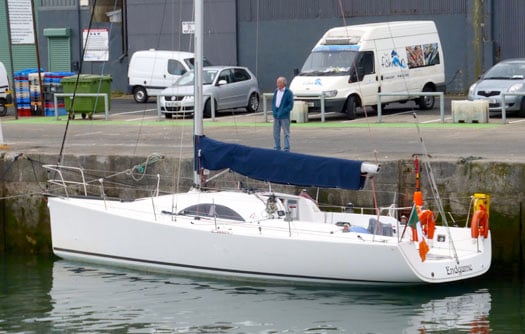
Like father, like son. Denis Doyle's son Frank's A35 Endgame from Crosshaven berthed in Wicklow waiting for the start of the Round Ireland Race 2014, in which she placed fourth overall and was a member of the winning team for the Kinsale YC Trophy. Photo: W M Nixon
It was an attitude which they brought to every venue where Moonduster was raced. The Doyles believed passionately that boosting the local economy should be something that ought to be a priority in any major sailing happening, wherever it might be staged. Denis had been doing the biennial Fastnet regularly for many years before he took up the Round Ireland race as well, and for a longtime beforehand he and Mary had also had the Honorary Citizen status in Cowes, as he would make a job of doing Cowes Week beforehand, living in digs in the town, while at race's end in Plymouth, there'd be a local commitment as well, albeit on a smaller scale.
This was all very well for Wicklow and the Round Ireland in the circumstance of the 1980s, but by the 1990s other ports were developing marinas and providing convenient facilities, yet Wicklow stubbornly stayed its own friendly but inconvenient self. When we look at the geography of the harbour, we can see why, and see all sorts of things that might have been done differently a very long time go.
For instance, when the Vikings were first invading and intent on making Wicklow one of their key ports, it could have been developed in a much more useful way if only the native Irish had made them welcome. Can't you just see it? "We'll overlook the rape and pillage for now, lads, these guys represent substantial inward investment". Just so. Had there been that far-sighted attitude, the locals could have invited the men in the longships to come on up the River Vartry, and into the magnificent expanse of the Broad Lough. What a marvellous vision that would have revealed. With some minor rock removal and a little bit of dredging in the entrance, it could be a wonderful extensive natural harbour in a beautiful setting. Had that happened, just think how differently the facilities of modern Wicklow harbour might now be.
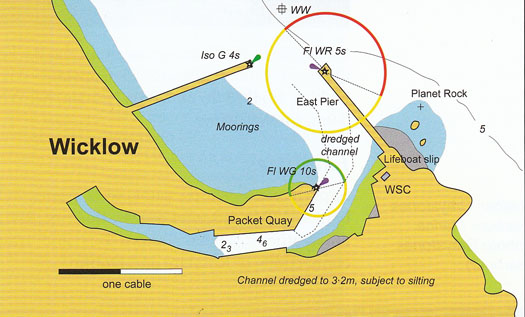
The navigable part of Wicklow Port as it is today. The water does not really come to a sudden straight-line stop as shown on the left – that's just the bridge. Plan courtesy Irish Cruising Club
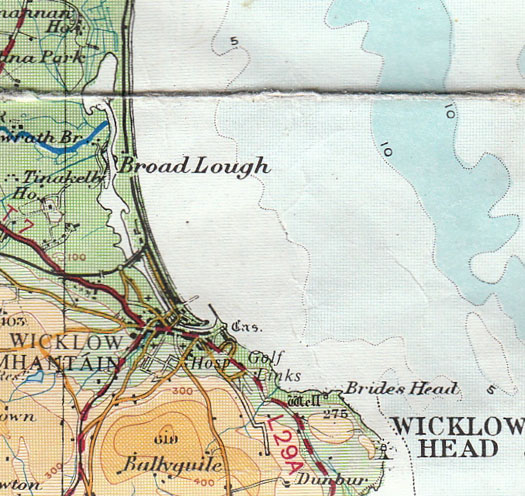
The bigger picture. Had the Vikings not been stopped such that they had to establish their settlement at the mouth of the Vartry River, they might have been able to create a much larger harbour settlement further in around the shores of the Broad Lough, with obvious advantages for Wicklow Port as it might have become today
Instead, the Vikings struggled ashore on the first available landing place at the first bend of the river, and established a beach-head which became such a successful little fort that eventually they were able to burn their boats. But by thattime, they were totally committed to having Wicklow town in its present cramped location. Access to the Broad Lough at high water (there's a very modest tidal range tidal) was soon restricted by the bridge, and then other river crossings, such that today nobody thinks of it as a potential harbour at all, if they ever did.
But meanwhile the current inner harbour is a cramped and dirty river which seems to be ignored by the town as much as possible, such that even the Bridge Tavern, the birthplace of Wicklow's most famous seafarer, Captain Robert Halpin of SS Great Eastern and trans-oceanic cable laying fame, turns its back firmly on the port. And as for the outer harbour, while it's a delightful place on a summer's day, it is not a serious proposition for berthing a large fleet of boats preparing for a major 704-mile offshore race, but people have to make do with it as best they can.
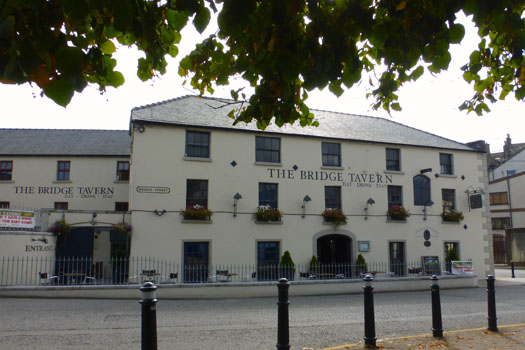
Despite being the birthplace of the most famous Wicklow seafarer, Captain Robert Halpin, the Bridge Tavern turns its back on the harbour. Photo: W M Nixon
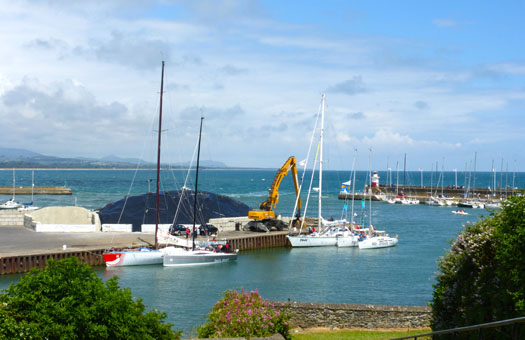
Wicklow's Outer Harbour on the morning of the Round Ireland race 2014 is a lovely sunny spot..............Photo: W M Nixon
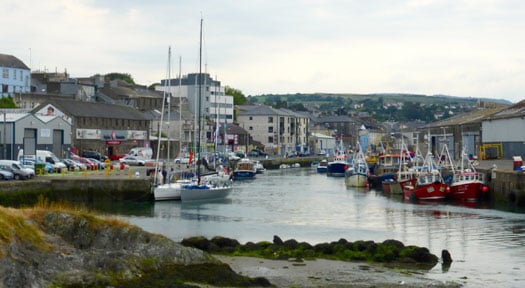
....but it is the inner harbour, shared with fishing and other commercial craft and assorted non-maritime quayside businesses, which will shelter the fleet preparing for the Round Ireland Race. Photo: W M Nixon
It was in the 1990s when the Round Ireland fleet was at its peak that the problems with the harbour's limited facilities were at their most acute, and it may be dormant memories of those difficult conditions which contribute to today's shortage of enthusiasm for the race. Back in the 1990s, the average cruiser-racer was not kitted out as a matter of course to RORC requirements, thus those undergoing their first scrutiny in order to be allowed to race round Ireland had to get to Wicklow several days in advance, and then often spendmoney like water to get up to scratch, the necessary bits and pieces being supplied by chandlers' vans parked on the quay.
It was crazy, not unlike a waterfront version of Ballinasloe Horse Fair - all that was missing was Madame Zara in her shiny caravan giving out nautical horoscopes in sepulchral tones for the wannabe Ireland circumnavigators. Perhaps she was there, but the two times I was going through the process with my own boat, it was so hectic I wouldn't have noticed. All I wanted to do was get to sea and away on the race, and get the filth of Wicklow harbour washed off the boat as soon as possible, as we'd drawn the short straw and had been berthed right in against the quay, so everyone has used our boat as a 35ft doormat on their way across to their own craft.
But the finish of the race at Wicklow – now that was and is completely different. The place seems to have transformed itself while you've been away bashing through sundry waters and a lot of the Atlantic in the intervening five days. Everyone is feeling like a million dollars, and Wicklow seems the only proper place in the whole wide world to finish a major offshore race. And as for the Round Ireland Prize Giving Dinner Dance, the venue of the Grand Hotel and beef or salmon for the meal is all part of the formula, it's central to the mystique of this extraordinary event.
In the days of the big entries with massive sponsorship from Cork Dry Gin, the prize-giving was Dublin-centred even if the race had started and finished in Wicklow. And the big bash in the city would start with a huge reception leading on into a gala dinner (I don't remember much dancing) in a glitzy Dublin hotel. In truth, it seemed a bit remote from little boats making their ways alone or in ones and twos back into Wicklow after the profoundly moving experience of racing right round our home island.
By the time you'd done all that, only others who have done the same could truly share your feelings about the experience. Big parties in anonymous city hotels were not the ideal setting for the Autumnal prize-giving and de-briefing. Thus the contemporary final hassle of getting down to Wicklow for the Round Ireland Dinner on a black November night in a veritable deluge of a downpour could be seen as the last stage of a long weeding-out process.
But once you're into the Grand Hotel and the party is under way, it's magic and the camaraderie really is quite something. Old rivalries and grievances fade away. It is also, to a remarkable extent, a family gathering – the number of family crews involved is surely exceptional. And the tone of it for 2014 is set by the presence of the winner of the KYC Trophy for the best three boat team, for the winners had as their top-placed boat the A35 Endgame, fourth overall and owner-skippered by Frank Doyle RCYC, son of Denis and Mary Doyle.
However, inevitably the status of the race and its future development and expansion is something which just won't go away. Any doubts about its importance were soon dispelled by considering the special guests at the dinner, as they included the President of the Irish Sailing Association David Lovegrove, the Vice Commodore of the Royal Ocean Racing Club Michael Boyd of the RIYC, and the Commodore of the Royal Irish Yacht Club, Jim Horan, whose club in 2014 was for the first time in association with Wicklow Sailing Club on the Round Ireland Race. The RIYC acted as hosting club in Dun Laoghaire for visiting boats which didn't want to go on down to Wicklow until shortly before the start, but wished toavail of modern marina facilities and the amenities of a large sailing port in the meantime.
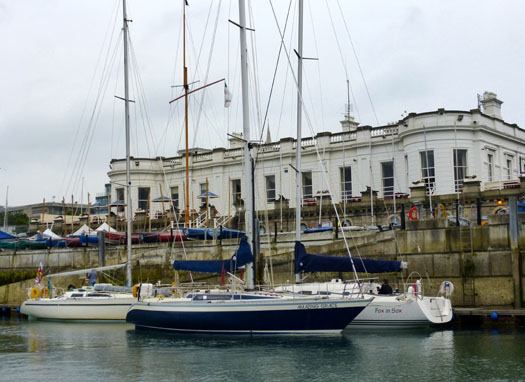
The switched-on crews going to Dun Laoghaire before the start of the Round Ireland Race 2014 knew that the best approach was to make themselves known at the Royal Irish YC and get a berth there, instead of allowing their boats to be banished to the "Siberia" of Dun Laoghaire Marina's remote visitors berths. Photo includes the MG38 McGregor IV from Essex which finished tenth overall (left), and the Oyster 37 Amazing Grace from Kerry, which had been in the frame but was forced to retire with equipment failure. Photo: W M Nixon
It was a partnership with potential, but it will need to be worked on. For although boats from other parts of Ireland knew that on arrival in Dun Laoghaire the secret of being well looked after was to make your number directly with the RIYC, boats from further afield coming into Dublin Bay tended to contact the marina, and thus they were stuck into Dun Laoghaire Marina's absurd visitors' berths, which are right at the very outer end of the pontoons, way out beyond acres of currently empty berths, such that it's said that anyone on them is one whole kilometre's walk from dry land.
Before the Round Ireland Race, the eventual winner Tanit was brought up from the Solent to Dun Laoghaire by a delivery crew who contacted the Marina Office, and she was stuck out in the Siberia of those Visitors Berths. It did mean that when she was first properly seen in Wicklow Harbour on the morning of the race, her impact as clearly an extremely attractive and very sound all round boat was all the greater. But nevertheless, if that is Dun Laoghaire Marina's idea of making visitors welcome, then they need to do something of a reality check, and it was a telling reminder that many Dun Laoghaire and Dublin Bay sailors are so absorbed in their own clearly defined and time-controlled activities afloatthat it leaves them with only limited attention for events outside their own sphere of interest.
As for Dun Laoghaire's general public, is there any interest at all? If the start of the Round Ireland Race was shifted to Dun Laoghaire, as some suggest, do you think the vast majority of the locals would take a blind bit of notice? At least in Wicklow they do make a bit of a fuss on the day of the start, with a community-sponsored fireworks display the night before.
In a final twist, in setting up the new Wicklow-Dun Laoghaire relationship, nobody had thought of the Greystones factor. Most had been unaware that the new Greystones marina is unexpectedly very deep. But such is the case, as I learned on Saturday night from the man from Newstalk. It's one of the reasons it cost the earth to build the little place. But it did mean that, in the buildup to the Round Ireland Race, while two of the deepest boats, the Volvo 70 Monster Project chartered by Wicklow's "Farmer" David Ryan, and the Farr 60 Newstalk, were unwilling to berth in Wicklow itself, they'd only to go a few miles north to find a handy berth in Greystones, where they were still very much in Wicklow county. There, they were the focus of much attention. For as we've discovered at Afloat.ie, if we lead a story #greystones, the level of interest is amazing.
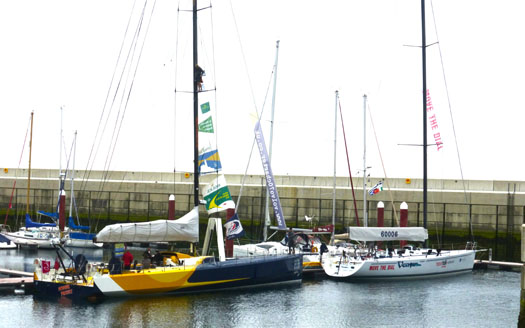
The exceptionally deep water in Greystones Marina provided trouble-free berthing for the Volvo 70 Monster Project and the Farr 60 Newstalk. Photo: W M Nixon
Perhaps after their attendance at the Round Ireland Dinner in Wicklow last Saturdaynight, Tanit's crew now have a better understanding of why the Round Ireland Race is in its present format. And I certainly understand why the level of close personal attention which goes into the race administration by the small team in Wicklow SC running it adds greatly to its appeal for dedicated participants. Before going to Wicklow, I'd been checking with the eternally obliging Sadie Phelan of the race team whether or not Richard Harris would be there, as I had to admit I thought his boat was only gorgeous. "Of course he'll be there" says Sadie, "and I'll put you at his table".
Not only that, but the winner Tanit's table and the runner-up Ruth's table were cheek by jowl, so much so that I was almost sitting at both of them. It would have taken a team of scribes to collate all the information flying back andforth, but everything was of interest.
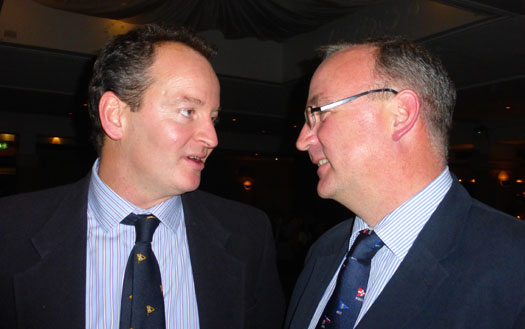
Just six minutes separated them at the end.....winner Richard Richard Harris of Tanit (left) and runner-up Liam Shanahan of Ruth at the Round Ireland prize-giving in Wicklow last Saturday night. Photo: W M Nixon
Richard (42) and his brother have owned Tanit for about twelve years, but as his brother is into gentler forms of sailing, the offshore campaigns are exclusively Richard's territory. In early sailing in the Clyde, they'd campaigned a Sweden 36 with their late father while Richard's own pet boat was a classic International OD. But as his interest in offshore racing grew, heidentified the Australian Murray Burns Dovell-designed Sydney 36 as ideal for their needs. He found there was only one in Europe, a 1996 one, little-used and in the Solent. They soon owned her, and changed her name to Tanit as the family firm is Clyde Leather, a vibrant firm which is the only suede tannery in Scotland.
Thus as raced in the Round Ireland, Tanit had the logo of Clyde Marine Leather on her topsides - a useful sideline is suede products for marine use, including a very nifty range of attractively-priced DIY kits for encasing your stainless-steel steering wheel in suede. Show me a boat which has a bare steel wheel, and I'll show you a boat which is on auto-pilot for an indecent amount of the time. But if you are doing the suede coat thing on your helm, be sure to cover the spokes as well, it makes all the difference for ultimate driver comfort.
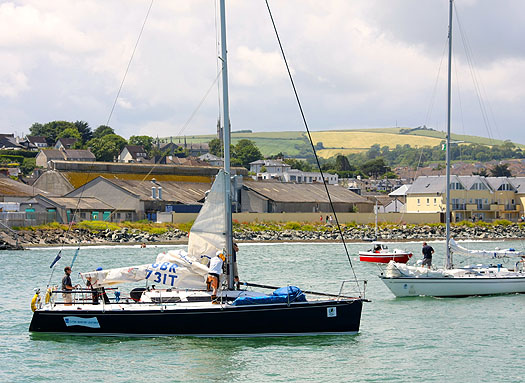
The boat from God knows where....Tanit (left) was an unknown quantity when she made her debut in Wicklow Harbour on the morning of the Round Ireland Race 2014, but father and son crew Derek & Conor Dillon's Dehler 34 Big Deal (right) from Foynes had already taken part in a couple of ISORA races, and went on to win the two-handed division and place 8th overall. Photo: Kevin Tracey
Gradually, they built up Tanit's campaigning in the Clyde, and most of the crew who currently race the boat have been together for seven years. They also chartered a boat to do the Hobart Race of 2008, but as Scottish offshore racing numbers declined, they decided to give it a whirl with the RORC fleets in the English Channel by moving Tanit down there. They found that the programme of concentrated doses of large-fleet intense offshore racing, all taking place at a venue two hours' flight from Glasgow, suited them very well – they could be totally domesticated when at home without the distraction of the boat being just half an hour's drive down the road.
The Sydney 36 of Tanit's type ceased production in 1997, the Sydney 36 you'll tend to come across now on Google is a new 1998 design. So when Tanit's rudder was wrecked after the 2011 Fastnet (a good race for them), it was something of a disaster as a replacement rudder could no longer be supplied off the shelf. It was even more of a disaster for the unfortunate woman who was driving her five-day-old Range Rover around the boatyard in Southampton where Tanit had been hoisted after returning from the Fastnet finish in Plymouth, for not only was her absurdly big shiny new vehicle severely damaged in somehow colliding with the rudder of the Scottish boat, but it turned out that an inevitably custom-built replacement would cost a cool 35K sterling for her insurance company, as that was one very special rudder.
It was a disaster all round, for by the time they'd identified a high tech builder of sufficient repute prepared to build the new rudder, they had missed most of the 2012 season. Then the 2013 Fastnet Race had too much reaching to suit them, as Tanit is at her best upwind and down. So with Richard's brother making louder noises about selling Tanit in order to suit his more sybaritic preferences afloat, the Round Ireland Race 2014 came up on the radar as being an opportunity for what might well be the last hurrah with a much-loved boat.
They needed a navigator, and preferably one with some experience of the Round Ireland course. Fortunately John Highcock of Saturn Sails in Largs, who regularly races with Tanit as one of those ace helmsmen who can seem to smooth the sea, had sailed with Richie Fearon and suggested him with the highest possible recommendation, so the Swilly man was brought on board.
The rest of the crew were complete round Ireland virgins, but they found the race suited their style and level of sailing very well indeed. In any Round Ireland Race, seasoned observers can usually identify beforehand the half dozen or so boats which will be serious contenders for the overall handicap prize, but which one actually wins will depend on the way the chips fall. But Tanit was something of an unknown, a wild card. Yet it wasn't very far into the race before it became clear that this was a good boat on top of her game, if things came right she'd the makings of a winner.

Tanit settling in after the start. The quicker they got south, the sooner they got back into the sunshine........
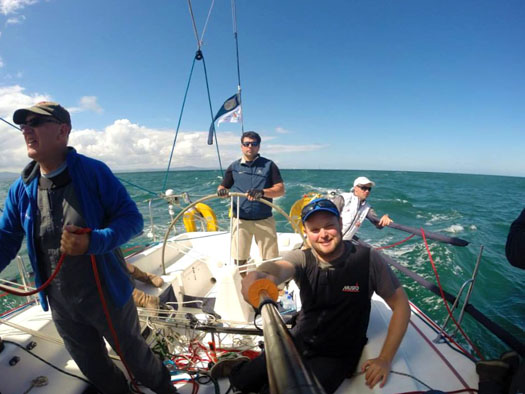
....and nearing the Tuskar Rock on the Saturday evening, they were back in sunshine, and well in contention on the leaderboard.
Within the limits of having a sensible boat which professionals would describe as a comfortable cruiser-racer, they campaign flat out. All meals are built around expeditionary and military Ration Packs, which can be quite expensive to buy in ordinary circumstances, but if you can show they're going to be used for a worthy objective, it's possible to swing a deal, and as Richard's wife Vicky is a physiotherapist who is involved with military reserves, the value of Tanit's campaigns is accepted in the right places. The result is a nourishing supply of reasonably attractive easy-prepare instant food which, as Richard reports still with some wonderment, makes no mess at all in and around the galley, yet keeps the crew on full power.
By the time they got up off the Donegal coast, Tanit was right in there, battling with the defending champion, the Gouy family's Ker 39 Inis Mor, for the overall handicap lead, while up ahead the two biggies, Teng Tools (Enda O'Coineen and Eamonn Crosbie) and the Volvo 70 Monster Project, with David Ryan of Wicklow, kept finding new calms as they tried to shake off the smaller craft.
It was a slow race, but Richie Fearon managed to place Tanit so that she stayed ahead of a calm up in his home waters, and was keeping station on Inis Mor very handily indeed, while the gap with boats astern widened all the time. Or so it seemed. But then the Round Ireland Race pulled one of its regular tricks, and Liam Shanahan and his team on the J/109 Ruth began to shift before they'd even got past Tory Island, and they appeared to carry a useful breeze and a fairtide the whole way from Donegal into the Irish Sea, or at least that's how it looked to the rest of the fleet.
But in closing in over the final stage from Rockabill to Wicklow, navigator Fearon – who was incubating a nasty virus which required antibiotic treatment for a week after the race - convinced Tanit's skipper that they should stay offshore, while Ruth – which seemed to have the race nicely in the bag – followed the Irish habit of hugging the coast. Inis Mor was already finished on Friday morning, but Tanit knew she was beatable by them, and when they came across the line at 1030, it was to move into the CT lead. And going offshore proved to have been their win move.
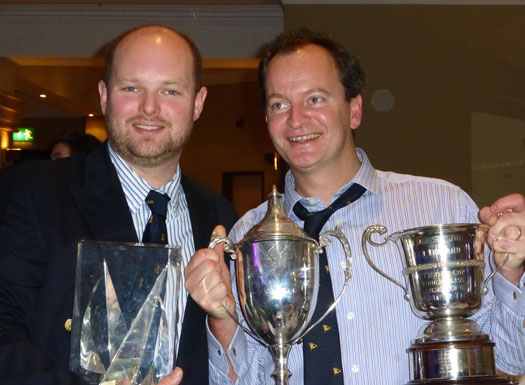
Trophies of the chase – crewman Chris Frize (left) and skipper Richard Harris with some of Tanit's prizes in Wicklow last Saturday night. Photo: W M Nixon
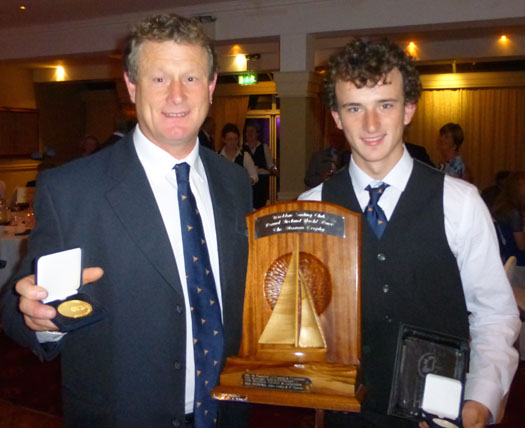
Family effort. Father and son team of Derek and Conor Dillon from Listowel in Kerry (they sail from Foynes) won the two-handed division with their Dehler 34 Big Deal, and placed 8th overall. Photo: W M Nixon
It was a time of screaming frustration for Ruth. She'd been crawling along near Bray Head, barely 15 miles from the finish, as long ago as 0700. She rated only 1.016 to the 1.051 of Tanit. A finish in the middle of lunchtime would do fine. It was so near. It was so far. Finally they got to Wicklow, but Tanit had them beaten by six minutes. Then for the Scottish boat there was just the chance that Ian Hickey's very low-rated veteran Granada 38 Cavatina might do it again. But the wind ran out for her too. Meanwhile Frank Doyle's Endgame came in at mid-afternoon to slot into fourth on CT behind Inis Mor, but Cavatina was fifth, all of five hours corrected astern of Tanit. The Scottish boat was now unbeatable leader.
Tanit's crew for this classic sailing of a true offshore classic was Richard Harris, Richie Fearon, John Highcock, Alan Macleod, Chris Frize, Andy Knowles and Ian Walker. They've a lovely boat of which they're justifiably very fond, but reality has intruded, and now she is indeed for sale. The price is 48K sterling which seems to me very reasonable when you remember that she is remarkably comfortable to sail, that sails and gear have been regularly up-dated, and that we know for certain that the rudder alone is worth 35K.......She's conveniently located for an Irish potential owner, as she's currently ashore in Glasgow. Certainly she has a performance weakness, for as Richard admits, she'll easily get up to 7 knots on a reach, but stubbornly stays there and goes no faster, yet if you harden on to the wind, she'll still be doing 7 knots. But if you go downwind, then whoosh – it's a horizon job on most other boats. Be careful what you wish for, though. With a boat like Tanit in an average fleet, there'll be no excuse for not doing well......
The rest of the trophy placings are here, and on Saturday night they were one lovely compact crowd of people. The family emphasis was inescapable, and it was a particular pleasure to meet the Kerry duo, father and son crew Derek and Conor Dillon from Listowel, who sail out of Foynes in their Dehler 34 Big Deal. In 2015, they plan to take on the two-handed division in the Fastnet, so getting 8th overall and winning the two-handed class in the Round Ireland 2014 was part of a very useful campaign trail.
Finally, as to how to keep the Round Ireland race's distinctive Wicklow flavour while allowing the entry numbers enough room to comfortably expand, it's such a tricky question that it will require a radical solution. A very radical solution. The mistakes of the Vikings must be undone. The Vartry entrance must be dredged, The bridges must all be removed. And the Broad Lough must be tastefully developed to give Wicklow the harbour it deserves, and the Wicklow Round Ireland Race the facilities it needs to cater for a fleet of a hundred and more boats. Simple, really.
ROUND IRELAND RACE TROPHY WINNERS 2014
Line Honours: Denis Doyle Cup - Monster Project (David Ryan, WSC)
IRC Class CK: CK Cup – Monster Project
IRC Class Z: Class Z Cup - Newstalk for Adrenalin (Joe McDonald, NYC)
IRC Class 1: Tuskar Cup – Inis Mor (Laurent Gouy, CBC)
IRC Class 2: Fastnet Cup – Tanit (R Harris, SYC)
IRC Class 3: Skelligs Cup – Ruth (L Shanahan, NYC)
IRC Class 4: Tory Island Cup – Cavatina (I Hickey, RCYC)
Class 5 (Cruiser HF) – Cavatina
Class 6 (pre 1987) Michael Jones Trophy – Cavatina
Class 7 (two-handed) Noonan Trophy – Big Deal (D & C Dillon, FYC)
ICRA Trophy (best Irish boat) - Ruth
Ladies Award: Mizen Head Trophy - Pyxis (Kirsteen Donaldson)
ISORA Award – Ruth
Team Award: Kinsale YC Cup – Endgame (F Doyle), Wild Spirit (P Jackson) & Fujitsu (D B Cattle).
IRC Overall: Norman Barry Trophy – Tanit
Round Ireland Overall: Wicklow Cup - Tanit

Monster boat, monster prizes. Line honours and Class C winner David Ryan of Wicklow, who raced the Volvo 70 Monster Project to success, with Roisin Scanlon, also WSC, who crewed on the Monster during the Round Ireland Race Photo: W M Nixon
Say Hello to 46m Superyacht 'Christopher', Dun Laoghaire Marina Welcomes Biggest Ever Visitor
#superyacht – Even seasoned observers are gobsmacked at the sheer size of the 46–metre (150–foot) Superyacht Christopher berthed at Ireland's biggest marina in Dun Laoghaire harbour marina this morning. Dwarfing the 500–local craft moored around it, and at twice the size of the biggest visiting race boats for this Saturday's Round Ireland race, the dark blue hulled Ron Holland Design cruising ketch which has arrived in overnight from Belfast is an impressive sight in the flesh. Now berthed close to the western edge of Dun Laoghaire's five gold anchor marina the superyacht crew are here to 'enjoy all the delights that Dun Laoghaire and Dublin City have to offer'.
Builders Pendennis say the Cayman Islands registered Christopher 'celebrates classic traditions yet embraces new sailing technologies performing equally well as a beautiful family 'home from home' and a performance sailing cruiser'.
The arrival has prompted much speculation about whether Christopher is the largest ever private yacht to visit the east coast port. In a throwback to Victorian times, when Dun Laoghaire was at the centre of yachting devlopment there were a number of very large yachts moored here. For example, in a recent blog by WM Nixon on the subject, the 1865-built schooner Egeria was one of the most successful boats owned by a Royal St George YC member during the halcyon years at the height of the Victorian era, when the club's yacht fleet tonnage was one of the largest in the world. But even Egeria's 100–foot is no match for Christopher.
Innovative technology included twin rudders, a pivoting keel and powerful rig and carbon rigging that provided performance as well as a shallow draft, and infra-red shielding in all windows reducing heat transfer into the accommodation thereby minimizing air con requirements. Her twin balanced rudders are a departure for a large cruising yacht and have been incorporated to maximise sailing performance in strong wind conditions and to allow space for a large Williams Turbojet 505D tender in the lazarette.
The retractable centre board was manufactured using precise CNC systems and when lowered, 'bomb bay' closing doors are deployed to reduce turbulence along the keel bottom.
This is also the first Ron Holland Design Yacht to incorporate all carbon fibre rigging. Another first is the deletion of any mizzen mast jumper strut and stays. This detailing has set a benchmark for improving the sailing performance of large cruising yachts.
The yacht was in Falmouth in the Autumn of 2013 for a winter refit, due to be completed before competing in the 2014 Pendennis Cup. Works include a Lloyd's annual survey; rejuvenating teak cladding and deck; hydraulic system checks and minor interior adjustments.
Pendennis Sailing yacht Christopher Features:
LOA 46m (150.9ft)
Draft 3.8m (12.5ft keel up), 9.4m (31ft keel down)
Beam 9.5m (31.2ft)
Naval Architects Ron Holland Design
Interior Design Ron Holland Design & Pendennis
Owner's Representative Duane MacPhail, Palm Beach Yachts International
#beneteau21 – The Beneteau 21 (B21) class association, which caters for owners of Beneteau 210, 211 and 21.7 boats is hosting an open day in Dun Laoghaire on June 7th. The new 'Dublin Bay 21' class featured in Winkie Nixon's sailing blog on Afloat.ie last season.
The B21 is emerging as a strong one design class where the racing is friendly and the ownership costs are low. The boast are versatile, being a good compromise between racing and weekend cruising.
The objectives of the open day are twofold. The first is to give people with a little sailing experience a chance to race on the Beneteau 21 and they might then become regular crew on one of the boats. The second is to give prospective owners and owners who don't currently race the opportunity to try out racing in a low pressure environment.
The format for the day is:
Meet 09:45 at the Dun Laoghaire Marina.
10:00 Briefing
10:30 Introductory sail on a Beneteau 21.
12:00 Raft up for lunch in the Royal St George Yacht Club
13:00 Leave to compete in the afternoon DBSC race (weather permitting)
17:00 Debriefing and a pint!
There is no charge for the day, however we are asking people to register by texting your name and email address to 087 1228665.
#irishsailing – After five years of economic contraction, there are signs of recovery, and the 2014 Irish sailing season has also got off to a flying start. W M Nixon looks at various signs of new energy and initiatives, and sees how they might be affecting stories which have been run on this blog and in the Afloat.ie website during the past year. But he concedes that further cost reductions will be necessary for the good of the sport.
A year ago, any talk of green shoots in Ireland was almost entirely metaphorical. And it was in the economic sphere, though even there they were still few and far between, with many soon stunted. But out in the farmers' fields themselves, out where the grass should have been growing, there was scarcely a sign of life as we were still trapped in the coldest and most miserable Spring in living memory, and all forms of growth and recovery were blighted by it.
Sailing and boating, of all sports, are the most affected by Ireland's climatic conditions. Not only is the mood among participants strongly influenced by weather which sometimes can get anyone down, but without reasonable breezes, sailing events are seriously impaired. "We got a result!" may well be the PRO's final desperate claim after pulling some sort of a points table and leaderboard out of a series bedevilled either by too much or too little wind. But it's so much better to have a series bathed in sunshine and blessed by fine breezes, with enough races sailed for the crews to go home tired but happy without needing recourse to any of those weasel words which show you're only trying to justify a weekend of frustration.
Things could not be more different this year. The Spring of 2014 has been perfection, boats are going afloat on time and in reasonable weather conditions, and the first little crop of events and results are very encouraging indeed - so encouraging, in fact, that "little crop" doesn't do them justice.
That said, two of the nearer events which gave special cause for Irish celebration did not have perfect weather throughout. The Youth Sailing Nationals at Howth may have ended on a high with a great breeze in an early taste of summer sunshine, but one day out of the four was lost to bad weather. But the sting of that was lessened by the decision for "no racing all day" being taken at 1100hrs, which allows other leisure options to kick in.
The IRC Easter Championship in the Solent concluded through Easter Monday literally with "Darkness at Noon" – the heavy clouds and torrential rain on an almost windless day saw the final races being sailed with nav lights on. But there had been excellent racing on earlier days, and a very excellent result with Anthony O'Leary's Ker 39 Antix from Cork the clear supreme champion.
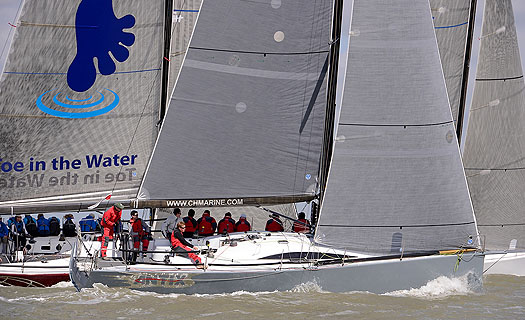
Doing the business. Anthony O'Leary's Ker 39 Antix settling into the groove on the way to the top place in the Easter IRC Championship. Photo: Rick Tomlinson
That in turn augured well for Ireland's Commodore's Cup chances, which then received a further boost last weekend when the crew of another Irish team wannabe, Quokka with Michael Boyd and Niall Dowling, had a winning weekend in the Warsash series with their temporary mount Tarka in anticipation of Quokka's return from the Caribbean at the end of May.

The Colours Match team racing between UCD and Trinity served up top sport in the Liffey, with Trinity winning. Photo: W M Nixon
Meanwhile the universities racing has been brought to life, for although UCD had a convincing win in the racing with the SailFleet J/80s to become the Irish team for the Student Yachting Worlds in France in the Autumn, before April was out the Colours Match in the Liffey under the burgee of the Royal Alfed YC, team-raced in Fireflies, saw Trinity take the honours in convincing style.
But if we're looking for something which really did set things freshly alight, it was out in Hyeres where the ISAF Championship saw the northern duo of Ryan Seaton & Matt McGovern take silver in the 49er, almost immediately moving them up the global rankings from 33 to 11, a quantum leap and no mistake.
The potential for serious success by these two has been fairly obvious for some time, but anyone who sails boats will know only too well how many factors have to come into alignment to get you up among the magic metals at the end of the day.

Stars of the silver sea – the Seaton/McGovern team took a silver medal for Ireland at Hyeres.
That their new global status was almost immediately acknowledged by this rankings improvement will in turn add heft to everything they do and say. Thus when, some time ago, the Ryan/Seaton equipe suggested that the 2016 Olympics sailing waters in Brazil are so off the standard as to be a health hazard, it attracted polite attention. But now that they're Number 11, and still counting down, much more notice is taken. And the fact that the Vice President of the International Olympic Committee has suggested, with something approaching despair, that the facilities in Brazil just aren't going to be ready for 2016 at any standard, all gives added legs to the statement from Ireland's 49er crew.
This in turn makes us wonder where world sailing might go in 2016 if the Brazilian setup is still Work in Progress. With tongue only slightly in cheek, we suggest they need look no further than West Cork, where Baltimore Sailing Club has been expanding its facilities to meet increased demand as a club which last year introduced something like 700 people to sailing. That BSC and current Mitsubishi Motors "Club of the Year" Kinsale YC further east along the West Cork coast have both been putting in premises up-grade during the past year, while other clubs have been having it tough, and just about hanging in there in some cases, surely gives pause for thought.
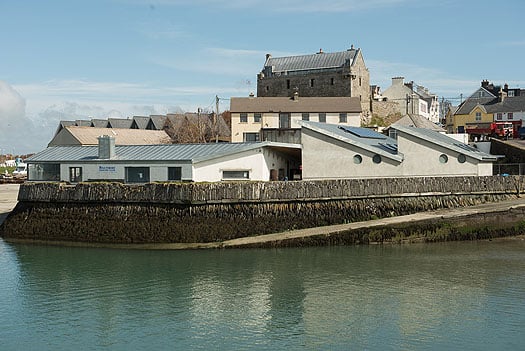
Olympic venue? The extended and up-graded Baltimore Sailing Club is ready and raring to go.
The economic shakeout of the past five years has caused a massive write-down in the value of almost all property and other assets. And in the case of yacht and sailing clubs, there has been a detailed examination of the continuing validity, or otherwise, of established yacht clubs and their traditional business model of quite high subscriptions under-writing other facilities which in turn combine to provide the complete package of an orthodox yacht club.
Inevitably, most clubs are run by officers and committee members who have been involved with the club for many years. Thus, like people who have been running a quality hotel for decades, they may have an inflated notion of what their organisation and its premises are actually worth. Admittedly there's only limited usefulness in comparing a yacht club with a hotel, but lessons can surely be learned. The fact is that hotels today are worth maybe only a third or even less of what they were reckoned to be worth six years ago. And equally, while yachts clubs certainly have a unique package to offer, is it unusual enough and special enough to charge high subscriptions when there are alternative facilities and services available?
The dilemma arises to some extent in all sailing centres. Last week we were discussing the story of the development of Howth YC. Today it is in the seemingly happy situation of having its own marina, thus it theoretically can offer an attractive all-in-one package to any potential member. But the very fact that Howth YC has done so much to help make Howth a colourful and vibrant sailing/fishing port is partly to its own disadvantage. The place has developed as a remarkable focus for top seafood restaurants. This means that the extensive club catering facilities – expected by traditional members - are constantly battling for business with a whole slew of award-winning eateries and characterful pubs nearby.
The problem is more acute in Dun Laoghaire in that the only club within the marina area is the Royal Irish YC. Thus while people may have been loyal members of the National, the Royal St George and the Dun Laoghaire Motor Yacht Club, they find that after going out in the boat, it's very easy to round out the evening aboard in the marina, chatting among themselves or with other crews on boats nearby, and then head straight for home without making their number in their home clubs at all.
This situation is less in evidence at weekends and during special events. But nevertheless it was causing such a lessening in mid-week club vitality that various steps have been taken, and the Royal St George's move to take over berths in a block booking in the outer marina, and service them by a frequent ferry direct from the clubhouse, is a visionary step.
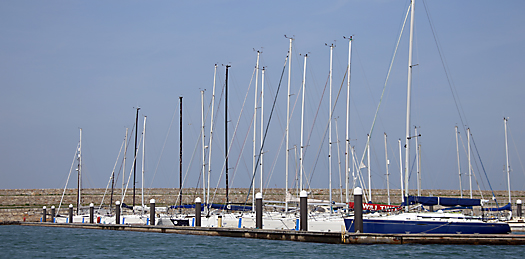
The Royal St George YC has introduced a direct ferry service from the clubhouse to its group of berths in the outer marina in Dun Laoghaire. Photo: David O'Brien
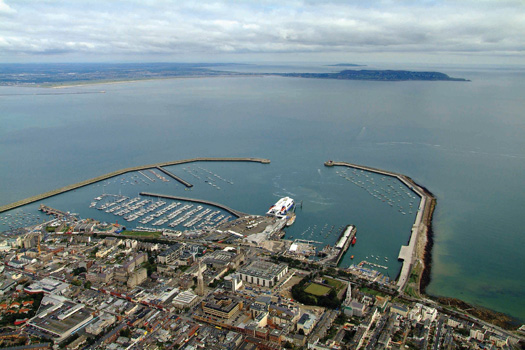
To overcome a lack of direct access to the Dun Laoghaire Marina, the Royal St George YC is running a ferry service from its clubhouse (to right of Stena Ferry, foreground) to the berths in the Outer Marina (upper left) Photo Kevin Dwyer/courtesy ICC.
Nevertheless, in all club administrations there are those who are of the opinion that, whatever the Honorary Treasurers may believe, there has to be a radical re-think of the primary subscription levels. In essence, they're suggesting that the book value of the club has to be written down such that subscriptions are halved. Personally, I haven't much of a notion of how to read a balance sheet, but the dogs in the street know that in the hospitality industry – which, in the broadest sense, is the area in which yacht and sailing clubs operate – values have been savagely slashed, and while charges may still seem high, at least the places are surviving as going concerns.
With continuing reduction in expenses across the board, one area in which there seems to be much work afoot is in the Irish Sailing Association, which in latter days had begun to seem like some hidden corner of the civil service, existing more for the benefit of staff than for the provision of services for sailors. It's amazing to learn that the ISA has sixteen fulltime staff, and a basic annual wages bill of something like €600,000. When you add in the expected benefits, it musty come in total to a very tidy yearly sum.
What on earth do they all do? While you'll invariably find the ISA logo in prominence at some top events, it has to be said that you're entirely unaware of the organisation's existence in any form at more everyday happenings, and it doesn't seem to be because they believe in doing good work by stealth. But with special study groups resulting from the major changes introduced in the ISA setup at the AGM in March, we can only hope that in time the Association will reflect the cost-cutting which has had to be introduced in the clubs, which provide the main part of the ISA's income.
While the administrative structures are rightfully being pared back in many areas of our sport, the coastal infrastructure, on which all forms of seagoing ultimately depend, continues to need maintenance and development. In this area, one very promising green shoot is the news that there are signs of movement in Dunmore East. A dredging programme is getting under way, and just this Tuesday, Minister for Marine Simon Coveney TD convened a meeting in the port to inaugurate a community approach to harbour development which, it is hoped, will help to invigorate the many places around Waterford Estuary, for which Dunmore East has the potential to be the true gateway harbour.

Dunmore East – can it fulfil its potential as the gateway leisure port for the Waterford Estuary? Photo Kevin Dwyer, courtesy ICC
In a more extreme marine environment, it has been confirmed that €6 million will be spent on improving the pier at Doolin in northwest Clare, the nearest mainland quay to the Aran Islands, which also caters for the tour boats cruising along the Cliffs of Moher. While the locals seem well pleased, I wouldn't get too excited about it. This is one very rugged part of the coast, and when you remember that it took €31 million to extend the pier at Kilronan in Inismor, the main Aran island, and another €14 million to build the little harbour at the north end of Inis Meain, the middle Aran island, then we can only hope that €6 million is going to achieve something more than a few boulders being shifted about in the roaring ocean at Doolin.

The pier at Doolin is decidedly minimalist, but it provides the shortest sea passage to the Aran Islands. Photo: W M Nixon
But then, in the west all things are possible, and along the ocean seaboard we're told that four thousand signs are being erected to guide people along the Wild Atlantic Way, the new tourism initiative using many smaller coastal roads. Quite so. Frankly, with signage at this level, it will be the Tame Atlantic Way by the time half of them are in place. I have to admit to being a complete curmudgeon in this. In many years of transitting Ireland's west coast by sea and land, one of our favourite areas while driving along the west coast has long been the coast south of Kilkee down to Loop Head, where the cliffs comfortably rival anything the vulgar Cliffs of Moher have to offer, and it is magnificently uncrowded. But not any more, if the Wild Atlantic Way movement has its way.
While I appreciate that visitor numbers have to be kept up and increased whenever and however, it has to be done in a way which appreciates that's what brings people to Ireland (rather than just to Dublin, which is a special case) is an unspoilt landscape. So, four thousand signs just for the one Atlantic Way? Ogden Nash had something to say about this:
"I think that I shall never see,
A billboard lovely as a tree.
But then, until the billboards fall,
I'll never see a tree at all".
Be that as it may, the final sign that suggests things are on the move again is a notice I spotted recently posted at a nearby club, though language pedants might wonder how a notice which manages to mangle so utterly the plural of "dinghy", even to adding a completely superfluous greengrocer's apostrophe, could be seen as encouraging in any way whatsoever.
Well, once you've overcome your opinions about the errors, the underlying message must be good news. More youngsters are evidently coming to sailing this year. And as for the spelling mistake, even that's an improvement. A year ago, the same notice board opened by referring to something called "a dingy", but this time round we have to get to the second line before finding that. And it all comes right for dinghies in the end.
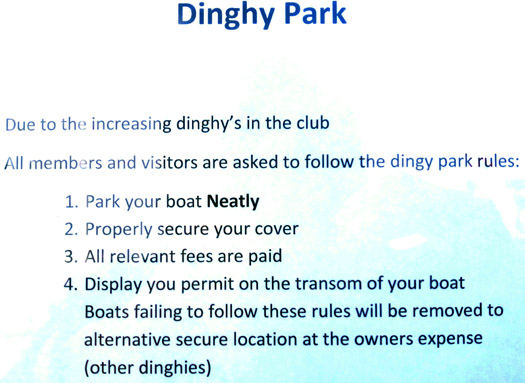
Sign of the times? Whatever about the spelling, this current notice at an Irish sailing club has an underlying message of good news. Photo: W M Nixon
#dlmarina – A year after yacht clubs reacted to a cut in Dun Laoghaire Harbour's swinging moorings, the Royal St. George, has vacated it s long held east bight moorings at the request of the Dun Laoghaire harbour Company and relcoated to the town marina.
The harbour company requires the east bight area to facilitate visiting cruise ships, a new area of revenue for the harbour.
The Royal St.George, the country's biggest club, says 'As opposed to doing a partial withdrawal over the 2014/2015 seasons we have agreed a new facility with Dun Laoghaire Marina in their West Bight section'.
It is intended that all Royal St George boats on the East Bight will relocate. Moorings in front of the club house are currently unaffected. The club says it has agreed a very favourable rate with the marina and takes into account the notified increases for mooring charges.
A launch service between the club and the Marina will be available and currently a scheduled service is being drawn up, this will be the only point of access to the West Bight.
The initial agreement between the club and the marina is for a period of 4 years.
The club website advises 'the West Bight berthing rate exclusive to RSGYC members will be €170 p/ meter vs. the Marina's advertised rate of €217.50 p/ meter' This rate is available from Lift In – Lift Out and only to RSGYC members that availed of moorings in the last few years.
For 2013 Royal St.George mooring rates were €147 p/ meter. With the increases from the Harbour Co for 2014 the rate would be in the region of €155 p/ meter, the club estimates.
The west bight marina facility will only be accessible from the RSGYC club house pontoons and will be served by the Launch Service with one pickup/ drop off point on the West Bight which will increase efficiency.
#mgmboats – The first of this season's new sailing marques has arrived into Ireland from France via go–ahead yacht brokers MGM Boats Ltd. The new 2014 Sun Odyssey 379, is on display at Dun Laoghaire marina today. For those interested in a new boat this season the 'On the water' price delivered to Ireland starts at €169,000 including VAT. Trade ins welcome and boat finance available, say MGM Boats.
Dun Laoghaire Marina Greets Classic Schooner 'Astor' Visitor
#classicboat – Schooner 'Astor' built by the famous Wm. Fife & Sons of Scotland in 1923. Teak planks over English oak frames. Originally commissioned for Dr McCormick of Sydney, Australia, Her homeport since 1987 is Newport, California, USA.
Although used mainly for cruising these days, this historic boat won the America Schooner Cup Race five times consecutively and has just finished up at the Fife Regatta 2013 where she was placed second in Class 1.
She is now in Dun Laoghaire Marina to allow the owners and crew to sample the delights of Dublin City, before she continues on her way with next stop, the Mediterranean.





























